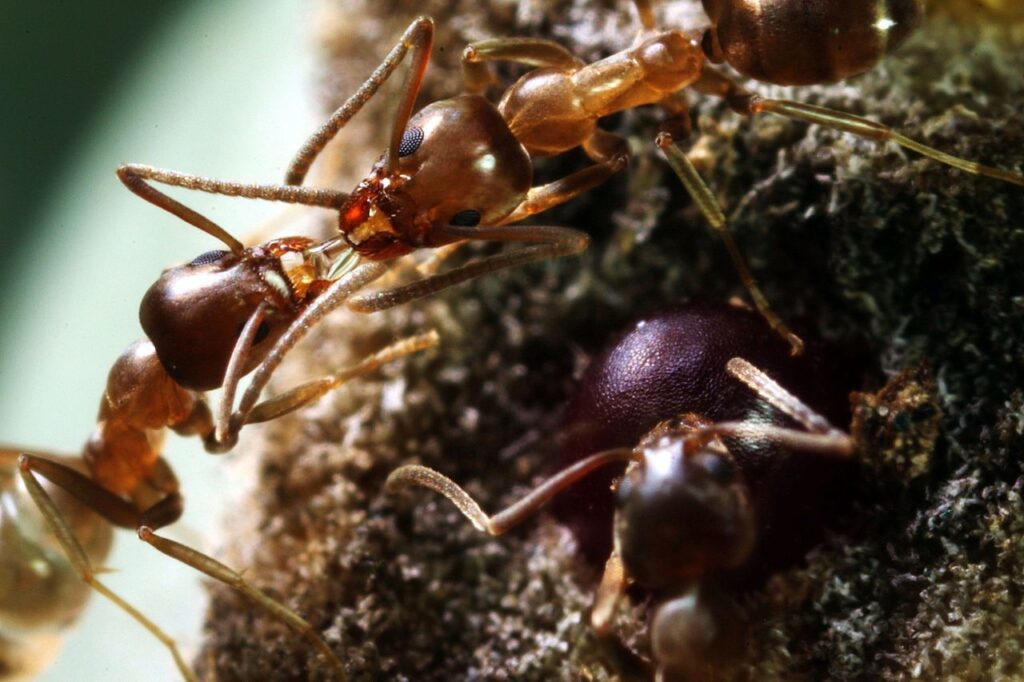
Argentine ants are among the most pervasive ant species in urban and suburban environments. They are small, typically light to dark brown, and range from 2.2 to 2.8 mm in size. Known for their aggressive colonization habits, Argentine ants form supercolonies with multiple queens, allowing them to expand rapidly and outcompete other native ants. Originally from South America, Argentine ants have spread across many parts of the world, often establishing themselves in regions with mild climates.
Argentine ants prefer moist environments, making homes, gardens, and areas near water sources ideal for their colonies. They are highly adaptive and can form nests in a variety of locations, from soil and leaf litter to wall voids and under rocks or logs. Unlike other ants that rely on a single queen, Argentine ant colonies contain many queens, each responsible for producing workers to support and expand the colony.
Argentine Ant Behavior and Diet
Argentine ants are omnivores with a preference for sweet substances. They frequently feed on honeydew, a sugary liquid produced by aphids and other insects, as well as on sugary substances inside homes. They forage in long trails, making their presence easy to spot, particularly in kitchens, pantries, and gardens where food and water are available. Argentine ants also consume proteins and fats when available, which helps support the high demands of their populous colonies.
Their sophisticated foraging habits allow them to quickly locate food sources and establish efficient trails to bring resources back to the nest. Argentine ants lay down a pheromone trail as they move, enabling others to follow directly to the food. This behavior often leads to rapid infestations when food or water is easily accessible, requiring a targeted approach to control.
Prevention and Control Tips
- Remove Food Sources: Clean up food and drink spills immediately and store food in sealed containers. Regularly empty trash bins and keep them tightly closed, as even small amounts of food can attract ants.
- Seal Entry Points: Inspect your home for gaps around windows, doors, pipes, and foundation cracks. Sealing these entry points can reduce their ability to access indoor spaces.
- Manage Moisture: Repair leaks and avoid standing water, as moisture attracts Argentine ants. Drip irrigation systems, leaky faucets, and unsealed pipes can contribute to infestations.
- Outdoor Maintenance: Trim back vegetation around your home and remove potential nesting sites, such as piles of wood, leaf litter, and rocks.
Professional Pest Control Solutions
Argentine ants are notoriously difficult to control due to their large colonies and multiple queens. While DIY methods can help reduce visible ant populations, professional pest control treatments are often necessary for long-term management. Professional treatments may include baiting and targeted insecticide applications to address the root of the colony rather than just the surface activity.
At Traffic Pest Solutions, we use proven methods to address Argentine ant infestations effectively. Our comprehensive approach focuses on identifying colony locations, using eco-friendly baits and treatments, and offering prevention recommendations. If you’re experiencing an Argentine ant infestation, contact us today for a free consultation and let our experienced team help keep your home or business ant-free.
Learn more about the invasive Argentine ant, its origins, large colonies, and impact on local ecosystems from UC Riverside’s Center for Invasive Species Research.
